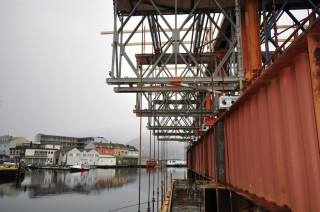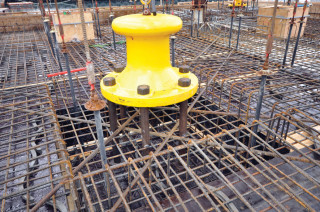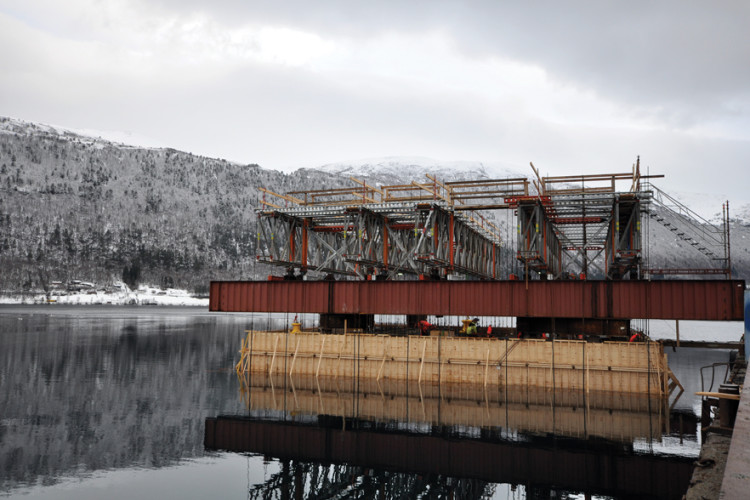The picturesque Norwegian town of Åndalsnes is tiny. But although it has a population of less than 2,500, it is one of the main stops for the enormous cruise ships that visit the fjords every year, each bringing thousands of tourists to admire the scenery and marvel at the Northern Lights.
These cruises are becoming increasingly popular, and as a result, the cruise ships are running more frequently and are getting bigger. To cope with the bigger vessels the harbour authority, Molde & Romsdal Havn, engaged Norwegian contractor Entreprenør M Kristiseter to extend the quay with a new 17m x 17m pier connected to the existing structure by a 60m-long, 4m-wide footbridge.
The Norwegian fjords are famously deep and the new pier sits on eight 1.2m-diameter tubular steel piles driven into the bedrock 70m below water level. The pier itself is a 780-tonne insitu concrete structure comprising a 700mm concrete slab supported on 1.2m-deep reinforced concrete beams cast 700mm above the surface of the water.
The location presented a unique problem: there was no other support available for the temporary works apart from the eight steel piles which form the foundations for the entire quay.
Kristiseter employed Norwegian concrete specialist Teknikk and its formwork supplier, RMD Kwikform, to provide a solution to this delicate problem.
After several concept designs, produced by RMD Kwikform’s UK engineering team in collaboration with Teknikk, it was decided to use a suspended system for the formwork. This would entail the assembly of a soffit system with all of the core structural support located above the quay instead of underneath.
The suspended soffit - supported by 180 steel hanger ties, each 20mm in diameter - consisted of two layers of RMD Kwikform’s Superslim Soldier primary beams, one layer of timber secondary beams and plywood sheeting. The hanger ties were passed through the entire concrete structure and down to the lowest layer of beams in the soffit, beneath the water level.
The entire assembly was fixed around the tubular steel piles, as Morten Hernes, project manager at Teknikk, explains: “Kristiseter cast eight steel support posts into the top of each tubular steel pile. Each of these posts protruded above the top of the core quay slab. Steel header beams then spanned between adjacent support posts, providing four additional support points at each corner of the quay.
Two groups of 22m-long steel beams spanned between the top of the header beams, and provided the support for five 19m-long R700 truss modules spanning at 90o to the beams. RMD Kwikform also installed wedge jacks between each beam and the R700 trusses; this ensured that the load could be released quickly and easily, without the need to undo all of the hanger ties.
The work had to be carried out during the winter months in order for the new pier to be ready for the summer tourist season. The short daylight hours, combined with bitter winter temperatures, presented a significant challenge, says Martyn Henry, export sales and business development manager with RMD Kwikform in the UK:


“The site team were carrying out their work in freezing temperatures, and working against the rising tide, day in, day out. It was vital that we provided the main contractor with a simple and efficient solution that allowed for maximum productivity during low tide,” he says.
“To make the removal of the equipment easier we provided waler plates on the hanger ties; these prevented the plastic tie sleeves from lifting during each concrete pour. The waler plates could also be screwed down onto the top of the hardened concrete, allowing the suspended soffit to be held in position while the equipment above the quay was removed.”
Despite the technical difficulties of supporting almost 800 tonnes of fresh concrete under a temporary suspended structure, the solution developed jointly by Teknikk and RMD Kwikform solved all the problems with relative ease, says Guttorm Balstad, project manager with main contractor Kristeseter.
“This has been a challenging project in many respects. Initially, we were looking into using a more traditional method to construct the quay, with the bearing structure designed with an underlying steel system and wedge jacks. However, this system didn’t provide us with enough space to carry out the works.
“Due to the headspace provided by the R700 beams, we have been able to use the concrete pump and crane down material very easily. We have been very reliant on this system; otherwise we believe it would have been an impossible task.
“This is truly an ingeniously designed system,” continues Balstad. “After contacting Teknikk and RMD Kwikform, we realised quite quickly that they had the solution we needed. This is a good illustration of how things should be carried out on site and how challenges should be solved.”
The pier was completed within the programme and before the first cruise ships of the season arrived in March. The upgraded quay, together with its new footbridge, was completed and ready for the summer cruises in June.

Got a story? Email news@theconstructionindex.co.uk



